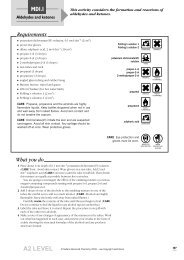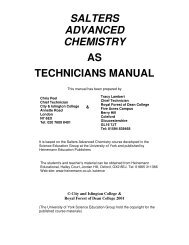Activities - Benjamin-Mills
Activities - Benjamin-Mills
Activities - Benjamin-Mills
You also want an ePaper? Increase the reach of your titles
YUMPU automatically turns print PDFs into web optimized ePapers that Google loves.
THE ORIGINS AND DEVELOPMENT OF THE MODERN PHARMACEUTICAL INDUSTRYWM1●●●techniques for in vitro fertilisation were developed, bringing family joy to manychildless couplesAIDS emerged and with it the discovery of a family of human viral pathogenscalled retroviruses, of which HIV is one, leading to entirely new medicines tocontain the virusadvanced scanning techniques were developed which have transformed thediagnosis and understanding of many human diseases.Built on these and many other developments, there has also been a revolution inthe number, specificity and safety of human medicines. It is here as much asanywhere that Britain has been in the front line: for the whole of the last half century,medical and medicines research in Britain has been the envy of the world for itsinnovative skills and high ethical standards. Even today, despite increasingpressure on funding and demands for greater safety in medical products, we stillenjoy this reputation. British hospitals are often a first choice for assessing thevalue of new medicines. Many European, Japanese and American ownedpharmaceutical companies choose to fund major research groups here. It is noaccident that today 7 of the top 25 medicines in the world, and 6 of the top 12medicines used to treat bacterial and viral infections, are the products of Britishpharmaceutical research.But the industry can also be proud of the contribution it makes to the Britisheconomy. UK earnings from the export of medicines exceeded imports by £2.3billion in 1997. On top of that, the industry employs the skills of more than 60 000people, including 20 000 highly-trained scientists and doctors.Disease 1935 1945 1955 1965 1975 1985 1995Scarlet fever 499 82 21 1 – – –Whooping cough 1473 689 88 21 12 4 2Diphtheria 3408 694 13 – 1 – 1Measles 1264 728 176 115 16 11 1Typhoid 170 44 15 8 1 – –Tuberculosis (respiratory) 23 840 19 668 5837 2008 722 408 355Syphilis 3521 2378 1385 857 110 40 9Heart disease(circulatory system) 103 613 127 969 138 313 151 718 299 669 287 054 241 871Cancer 62 602 73 753 91 340 106 474 123 769 141 618 140 791Total deaths 477 401 481 274 518 864 549 379 582 841 590 734 565 902Population (million) 40.65 42.63 44.44 47.67 49.47 49.99 51.52Table 1 Deaths from various diseases in England and Wales, 1935–1995 (The Stationery Office Annual Abstract of Statistics)A glossary of some of the diseases in the tableScarlet fever Infectious disease. High fever, sore throat. Caused bystreptococcal bacterial infection.Whooping cough Infectious disease of mucous membrane of air passages.Frequent attacks of convulsive coughing caused by bacteria. Vaccination possible.Diphtheria Infectious disease causing growth of membrane, often on tonsils,making swallowing difficult. The bacterium produces a toxin. Vaccination beganin 1940.Measles Viral infection. Causes fever and rash. Vaccine available.Typhoid A fever with ulceration of skin and bowels. Bacteria carried in sewagewhich is main cause of contagion.Tuberculosis Disease of lungs and other organs caused by bacteria. Improvedhygiene, vaccination and chest X-rays have helped to minimise its effects.Syphilis A sexually transmitted (or inherited) disease. Slow to manifest itself.Caused by a spirochaete. Results in death unless checked.AS LEVEL„ Salters Advanced Chemistry 2000 – see Copyright restrictions135
















![ISI Web of Knowledge [v.4.10] - All Databases Results - Benjamin-Mills](https://img.yumpu.com/39253071/1/184x260/isi-web-of-knowledge-v410-all-databases-results-benjamin-mills.jpg?quality=85)